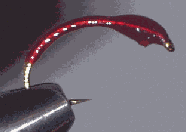Hints & Tips 1

It was a great pleasure to welcome Dave Coomber "back in the fold" recently when there was great interest in viewing his fly-boxes. Dave has prepared an article on some of his favourite flies which will appear in future issues. This photo of him shows his birthday gift to the editor some six years ago of "Flies which catch at Duncton". They were so beautifully tied and presented, that I never actually used them, except to put them on display at shows, etc!!
How many of us can boast that we take boxes like these below to go fishing? These are Dave Coomber's masterpieces, and he will describe his favourites. One point he has to make: tie three of each at a time for consistency and to avoid disappointment when you lose that successful fly! So over to you Dave . . . .
The fly I am going to discuss is the Shrimp. This is really a "confidence fly". In all honesty, I have not seen many anglers use these patterns; I have met two fishermen, one at Damerham and the other at White Sheet Farm, Dorset, who only use shrimps, and they had great success with these. I only use a shrimp when the going gets tough, i.e. hot, middle of the day, no breeze and the fish off the boil. I fish it on a long leader - let it settle, give it three quick jerks, a pause, and then a long pull, and then start again. I have done well at Duncton Mill and Chalk Springs. I have tied several types of shrimp, some of my own design These were illustrated in the Flydresser and Trout magazines. D.C.
The Editor's choice is another shrimp variation, the Red Spot Shrimp. The red spot represents the colouration caused by a parasite, which conveniently becomes an attractor to fish. (I recall Dave at a branch outing to Duncton, having taken his four fish, demonstrating his method of fishing this fly to a fishless colleague -"you just give it 3 tugs and then pull - oops, there it is!"-and this on the first pull of the first cast!! Dave had on a previous visit witnessed Ned Kelly pulling out masses of weed after cutting, and noticed the weed was swarming with shrimps.)

Dave's Shrimp

Orange Tag Shrimp

Red-spot Shrimp
Now, about some of the flies, I prefer. I try to use nymphs where possible, including buzzers, shrimps and various other forms of nymphs. Some of these are standard recognised patterns and some of my own design. The yellow-head is a particular favourite of mine; first used at Damerham some years ago, I have had a great deal of success with this fly. I tie it quite small, 14 - 12 size hook, with a narrow body of olive green marabou, gold rib, thin tail and a small yellow head made of narrow lead wire, painted yellow, with a black dot on either side for eyes. To fish use a fairly long leader of 15-17 feet long.
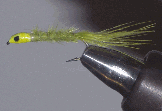
Yellowhead Green Nymph
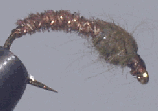
Cove's Nymph
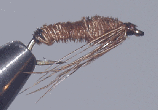
Sawyer's Pheasant Tail Nymph
Pheasant-tailed Nymphs
We must not forget the pheasant tail nymph, an all-time great, first used in rivers but now used in Stillwater everywhere. There are so many variants these days, but they all catch fish. Some of the most famous names attached to this fly are Frank Sawyer (the originator), Arthur Cove (arguably the finest exponent of nymph and buzzer fishing), Jim Tweeny from the USA, Al Troth, D Mason, Bob Church and so-on. You only have to look at Arthur Cove's Cove Nymph and sedge pupa to see how deadly they are.
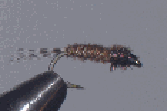
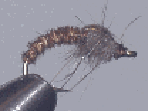
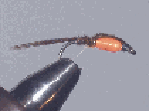

Pheasant Tail Variants
We must not forget the pheasant tail nymph, an all-time great, first used in rivers but now used in Stillwater everywhere. There are so many variants these days, but they all catch fish. Some of the most famous names attached to this fly are Frank Sawyer (the originator), Arthur Cove (arguably the finest exponent of nymph and buzzer fishing), Jim Tweeny from the USA, Al Troth, D Mason, Bob Church and so-on. You only have to look at Arthur Cove's Cove Nymph and sedge pupa to see how deadly they are.
